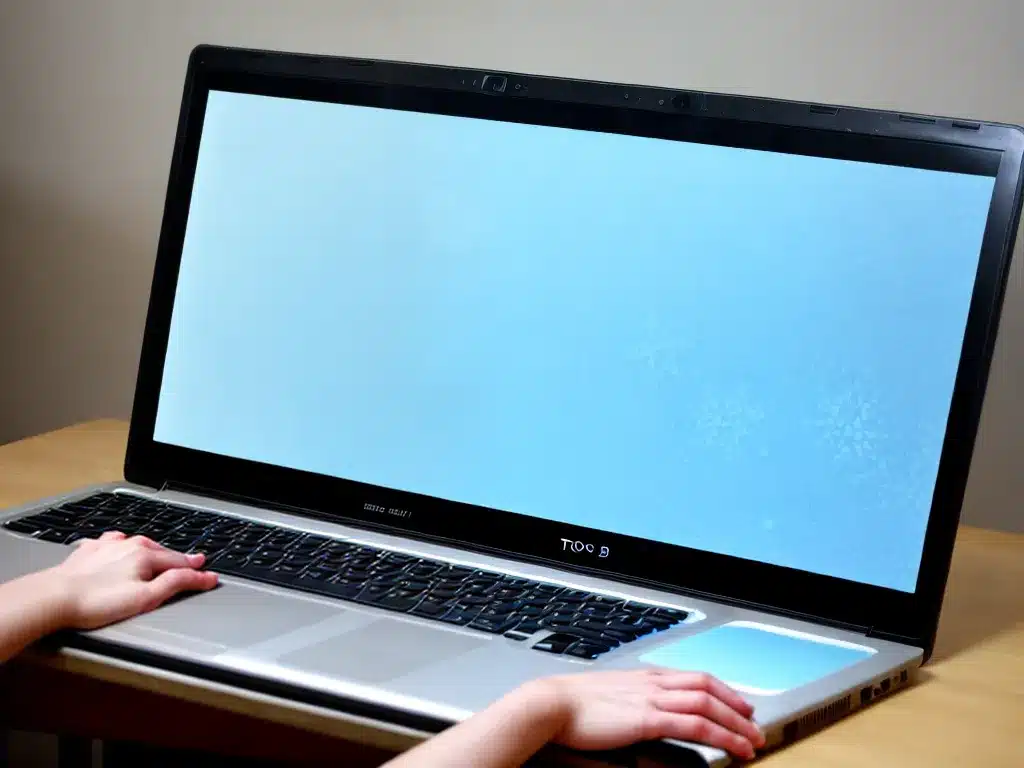
A frozen laptop screen can be incredibly frustrating. However, there are several things you can try to get your laptop screen back in working order. Here is a comprehensive guide on how to fix a frozen laptop screen.
Determine If It’s a Software or Hardware Issue
The first step is determining whether the frozen screen is a software or hardware problem.
A software issue is more likely if:
- The laptop was working normally before the screen froze
- You can still hear sounds and music playing from the laptop
- The laptop responds to keyboard shortcuts like Ctrl+Alt+Del
A hardware problem is more likely if:
- The screen froze after a drop or impact
- You see visual artifacts, flickering, discoloration or cracks on the screen
- The laptop does not respond at all to keyboard or trackpad input
Pay attention to when and how the freezing occurred. This can provide clues on whether it’s a software or hardware problem.
Try a Forced Restart
If the screen freeze seems like a software glitch, a forced restart may resolve it.
To force restart the laptop:
- Hold down the power button for at least 10 seconds to turn off the laptop
- Wait a few seconds, then turn on the laptop normally
This restart clears out any software issues causing the freeze. If the laptop boots up normally, the problem is likely fixed.
However, if the laptop screen remains frozen, a forced restart did not work. Troubleshoot further for a hardware issue.
Boot Into Safe Mode
Booting into Windows Safe Mode starts your computer with only the essential drivers and services. This can isolate and fix software conflicts causing freezes.
To boot into Safe Mode:
- Force restart your laptop if needed
- As it boots up, press and hold F8 repeatedly until the Advanced Boot Options screen appears
- Select Safe Mode and press Enter
If the screen unfreezes in Safe Mode, a software program or driver is likely the issue. You can then troubleshoot why that particular software is causing freezes.
However, if the screen remains frozen in Safe Mode, this indicates an underlying hardware problem.
Check Display Settings
Frozen displays may also be due to incorrect display settings like low screen resolution.
- Boot your laptop regularly into Windows
- If you can see the screen, go to Display settings and adjust the resolution
- Also disable any external display connections that may be causing interference
If adjusting display settings fixes your frozen screen, the problem was likely incorrect resolutions or connectivity issues.
Update or Reinstall Display Drivers
Outdated or corrupted graphics drivers can also lead to frozen laptop screens. Updating them may resolve this:
- Boot your laptop into Safe Mode if the main screen is frozen
- Open Device Manager > Display Adapters and note the GPU model
- Search for the latest drivers for your specific GPU from the manufacturer’s website
- Download and install the updated driver, then restart your laptop
If updating display drivers fixes your frozen screen, the problem was an outdated or buggy driver. Make sure to keep your GPU drivers updated in the future.
Reset Your Laptop
For deeper software issues, a full factory reset may be necessary:
- Back up your data, as resetting will wipe your storage
- Boot into the Windows Recovery Environment (WinRE)
- Go to Troubleshoot > Reset this PC and choose “Remove everything”
This will fully reinstall Windows and reformat storage, eliminating any corrupted software. If the screen unfreezes after resetting, you know the issues were at the software level.
Connect an External Display
If the main laptop screen remains frozen, connect the laptop to an external display:
- Use an HDMI or VGA cable to connect your laptop to an external monitor or TV
- Set that display as the only screen by closing the laptop lid
If the image appears normal on the external display, there is likely an issue with the laptop screen hardware itself. At minimum, the screen cable connections have failed.
Replace Screen Components
If an external display works but the laptop screen is still frozen, you will need to replace components:
-
Screen cable – Replace the video cable connecting the motherboard to the LCD. Faulty connections can cause freezing.
-
Screen inverter – Older laptops use inverters to power the backlight. Replace this if faulty.
-
LCD panel – If cables and inverter are fine, the LCD panel itself likely needs replacement. You may see cracks or distortions.
Replacing these screen components requires disassembling the display assembly. Consider taking your laptop to a repair technician for this.
Replace the Motherboard
In rare cases, even an external display does not work. This indicates the integrated graphics chipset on the motherboard is damaged. Replacing the motherboard may be necessary to fully fix a frozen laptop screen.
As you can see, frozen laptop screens can stem from both software and hardware issues. Methodically try the solutions above, isolating the problem. With the right troubleshooting, you should be able to determine and fix what is causing your laptop screen to freeze up.












